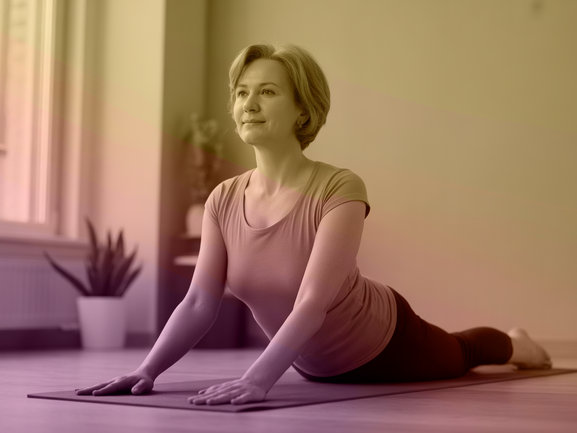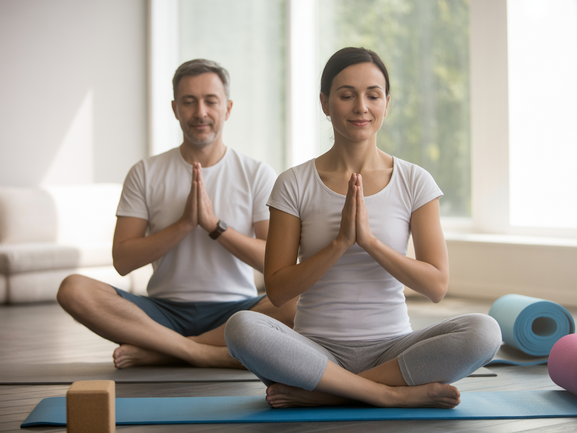
Yoga for High Blood Pressure: A 2025 Guide for a Healthier Heart
In a world where hypertension rates continue to climb, many are seeking sustainable, holistic methods to manage their health. Yoga for high blood pressure has emerged as a powerful, science-backed practice that combines physical postures, controlled breathing, and deep meditation to combat hypertension. This approach doesn’t just address the symptoms; it targets the root causes of cardiovascular stress, including both physical and psychological factors.
If you’re looking for an active role in managing your heart health, this guide is your starting point. We will explore how the ancient wisdom of yoga, amplified by modern technology, provides a clear and accessible path to lowering your blood pressure and enhancing your overall well-being in 2025 and beyond.
The Science of Serenity: How Yoga Impacts Blood Pressure
The connection between yoga and lower blood pressure isn’t just anecdotal; it’s rooted in deep physiological responses. The practice works primarily by activating the body’s “rest and digest” system, known as the parasympathetic nervous system. This counteracts the chronic stress-induced “fight or flight” response that keeps blood pressure elevated.
Key mechanisms include:
- Vagus Nerve Stimulation: Gentle yoga poses and deep breathing (pranayama) stimulate the vagus nerve, a critical component in slowing heart rate and instructing the body to relax.
- Cortisol Reduction: Regular practice significantly lowers levels of cortisol, the body’s primary stress hormone. High cortisol is directly linked to elevated blood pressure.
- Improved Circulation: The physical postures, or asanas, gently stretch and relax blood vessels, reducing arterial stiffness and promoting better blood flow. According to research from Johns Hopkins Medicine, this improved elasticity is crucial for a healthy cardiovascular system.
“A 2025 report from the World Health Organization highlights that over 1.3 billion adults live with hypertension. As a result, accessible lifestyle interventions like yoga for high blood pressure are now considered a critical first-line defense against this global health issue.”
Beyond the Numbers: The Holistic Benefits of Yoga for Heart Health
While lowering your blood pressure reading is the primary goal, the benefits of a consistent yoga practice extend to your entire well-being. These advantages work together to create a resilient cardiovascular system.
Profound Stress and Anxiety Reduction
Yoga’s meditative aspects train the mind to stay present, breaking the cycle of anxious thoughts that can fuel hypertension. By focusing on breath and body, you cultivate a state of mental calm that persists long after you’ve left the mat.
Enhanced Circulatory Efficiency
Gentle, flowing movements act like a pump for the lymphatic and circulatory systems. This helps deliver oxygen-rich blood more efficiently throughout the body, reducing the workload on your heart.
A Lower Resting Heart Rate
With regular practice, the heart muscle becomes more efficient. This often leads to a lower resting heart rate, a key indicator of good cardiovascular fitness and reduced strain on the heart over time.
Increased Mind-Body Awareness
One of the most transformative benefits is learning to listen to your body. This heightened awareness helps you recognize the physical sensations of stress, allowing you to intervene with a few deep breaths or a gentle stretch before it impacts your blood pressure.
Getting Started: Your First Steps with Yoga for High Blood Pressure
Starting a new health regimen can feel overwhelming, but beginning your yoga journey is simpler than you think. The key is to prioritize safety, consistency, and a gentle approach.
- Consult Your Healthcare Provider: This is the most critical first step. Discuss your intention to practice yoga with your doctor to ensure it’s a safe choice for your specific health profile.
- Choose a Gentle Yoga Style: Not all yoga is the same. Begin with styles like Hatha, Restorative, or Yin Yoga. These focus on slow, mindful movements and holding gentle poses. Avoid vigorous styles like Power Yoga or Hot Yoga initially.
- Master Foundational Breathing: Your breath is your most powerful tool. Practice simple diaphragmatic breathing: inhale slowly through your nose, allowing your belly to expand, and then exhale slowly, letting your belly fall.
- Build a Consistent Routine: Aim for 20-30 minutes a day rather than one long, infrequent session. Consistency is far more impactful for managing blood pressure than duration.
- Leverage Technology for Guidance: Modern tools can make your practice safer and more effective. Platforms like the Vitalizen.app, created by wellness tech innovator Jaime Lima Neto, offer structured programs specifically designed for heart health.
🎯 Ready to start? Using a guided app removes the guesswork and provides a clear, safe path forward.
The 5 Best Yoga Poses for a Healthy Heart
Certain yoga poses are especially beneficial for calming the nervous system and improving circulation. Incorporate these restorative postures into your daily routine. Hold each pose for 1-3 minutes, breathing deeply and evenly.
- Legs-Up-the-Wall Pose (Viparita Karani): A deeply restorative inversion that calms the nervous system, drains fluid from the legs, and gently lowers blood pressure.
- Bridge Pose (Setu Bandhasana): This gentle backbend opens the chest, improves circulation to the heart, and can help alleviate anxiety. Place a block under your sacrum for a more supported, restorative version.
- Cat-Cow Pose (Marjaryasana-Bitilasana): This dynamic duo synchronizes breath with movement, which helps to lower stress while gently warming up the spine and improving blood flow.
- Child’s Pose (Balasana): An essential resting pose that quiets the mind, relieves tension in the back and neck, and fosters a deep sense of relaxation.
- Corpse Pose (Savasana): Perhaps the most important pose for hypertension. Savasana allows your entire body to absorb the benefits of the practice, promoting profound relaxation and allowing your blood pressure to normalize.
Safety First: Practices to Avoid with High Blood Pressure
While yoga is generally safe, certain poses and breathing techniques can be counterproductive for those with hypertension. It’s crucial to be aware of what to modify or avoid.
- Intense Inversions: Poses like Headstand, Shoulderstand, and Handstand can significantly increase pressure in the head and chest. Stick to gentle inversions like Legs-Up-the-Wall.
- Strenuous Backbends: Deep backbends like Wheel Pose (Urdhva Dhanurasana) can cause strain. Opt for gentle versions like Bridge Pose.
- Breath Retention (Kumbhaka): Holding the breath can cause a rapid spike in blood pressure. Focus on smooth, continuous breathing instead.
- Overheating: Avoid practicing in overly heated rooms (Hot Yoga), as this can put extra stress on the cardiovascular system.
Always listen to your body. If you feel dizzy, short of breath, or any discomfort, gently come out of the pose.
The Cost of Wellness: Budgeting for Your Yoga Practice in 2025
The financial investment in yoga can vary widely, but advancements in technology have made it more accessible and affordable than ever. Here’s a look at your options.
| Option | Price Range (Monthly) | Key Features |
|---|---|---|
| Digital Apps (like Vitalizen) | $10 – $30 | Convenience, affordability, guided sessions for heart health. |
| Local Studio (Group Classes) | $80 – $200 | In-person guidance, strong sense of community. |
| Private Instructor | $250 – $800+ | Fully personalized attention and a tailored plan. |
| Free Online Resources | $0 | Highly accessible but may lack structure and safety oversight. |
For those focused on yoga for high blood pressure, a specialized digital app often provides the best balance of expert guidance, safety, and value.
Your Journey to a Healthier Heart Begins Now
Vitalizen is more than just an app; it’s a dedicated partner in your journey to a healthier, more balanced life. With a library of yoga and meditation sessions designed by experts specifically for heart health, our platform makes it easy to integrate these powerful practices into your daily routine. Our user-friendly interface and clear guidance ensure a safe and effective practice, whether you’re a complete beginner or have been practicing for years.
Are you ready to take the first, most important step towards managing your blood pressure naturally? Start your wellness journey now.
For more insights into wellness and technology, check the Vitalizen blog or visit our contact page for more information. For further reading on hypertension management, consider resources from the National Heart, Lung, and Blood Institute (NHLBI).



